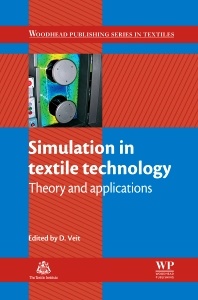Description
Simulation in Textile Technology
Theory and Applications
Woodhead Publishing Series in Textiles Series
Coordinator: Veit D
Language: English
Subjects for Simulation in Textile Technology:
384 p. · 15.5x23.2 cm · Hardback
Description
/li>Contents
/li>Biography
/li>Comment
/li>
Contributor contact details
Woodhead Publishing Series in Textiles
Acknowledgements
Preface
Chapter 1: Introduction to modelling and simulation in textile technology
Abstract:
1.1 Introduction to simulation
1.2 Simulation with and without computers
1.3 Modelling: white, black and grey box models
1.4 Expert systems and other knowledge-based models
1.5 Applications of expert systems to textile technology
Chapter 2: Neural networks and their application to textile technology
Abstract:
2.1 Introduction: biological background
2.2 Models of artificial neural networks
2.3 The backpropagation algorithm
2.4 Counterpropagation
2.5 Other types of neural networks
2.6 Applications of neural networks to textile technology
2.7 Practical advice in applying neural networks
2.8 Summary
2.9 Web references for software tools
Chapter 3: Evolutionary methods and their application to textile technology
Abstract:
3.1 Introduction
3.2 Biological background
3.3 Mathematical models of evolution strategy
3.4 Genetic algorithms
3.5 Comparison of evolutionary algorithms and iteration processes
3.7 Practical advice in applying evolutionary methods
3.8 Web references for software tools
Chapter 4: Fuzzy logic and its application to textile technology
Abstract:
4.1 Introduction
4.2 Imprecise mathematics
4.3 Set operations
4.4 Fuzzy logic versus probabilistic logic
4.5 Ultra-fuzzy logic
4.6 Fuzzy control
4.7 Fuzzy control with four input and one output variable
4.8 Applications of fuzzy logic in textile technology
4.9 Practical advice in applying fuzzy logic
4.10 Web references for software tools
Chapter 5: Computational fluid dynamics (CFD) and its application to textile technology
Abstract:
5.1 Introduction
5.2 From reality to simulation
5.3 Simulation of currents with fibres, yarns and textiles
5.4 Validation methods
5.5 Economic aspects
5.6 Applications of computational fluid dynamics to textile technology
5.7 Practical advice in applying computational fluid dynamics
5.8 Summary
5.9 Web references for software tools
Chapter 6: The finite element method (FEM) and its application to textile technology
Abstract:
6.1 Introduction
6.2 Modelling of mechanical systems
6.3 Elements of elastic models
6.4 Error estimation and refinement
6.5 Nonlinear problems
6.6 FEM Software
6.7 Future trends
6.8 Sources of further information
Chapter 7: Simulation of fibrous structures and yarns
Abstract:
7.1 Introduction
7.2 Fibres and yarns: definitions and factors affecting quality
7.3 Fibrous assemblies: volume, density and mass
7.4 Yarn parameters: fineness, density, diameter and twist
7.5 Modelling of internal yarn geometry: helical yarn model
7.6 Stress–strain relations
7.7 The relationship between yarn count, twist, packing density and diameter
7.8 A simple mechanical model of yarn properties
7.9 Mechanics of parallel fibre bundles
7.10 Examples of models of fibrous assemblies and yarns
7.11 Acknowledgement
Chapter 8: Simulation of wound packages, woven, braided and knitted structures
Abstract:
8.1 Introduction: objectives of simulating yarn- based structures
8.2 Principles of geometrical and mechanical modelling
8.3 Simulation of wound packages
8.4 Simulation of woven structures
8.5 Simulation of braided structures
8.6 Simulation of knitted structures
8.7 Future trends
8.8 Sources of further information
Chapter 9: Simulation of textile machinery
Abstract:
9.1 Introduction: simulation methods to optimize machine settings and product quality
9.2 Simulating yarn production and processing: ring/rotor spinning and false-twist texturing
9.3 Simulating fabric production: weft insertion and warp tension
9.4 Simulating finishing techniques: rolling and dyeing
9.5 Simulating plant layout and production planning: finishing operations
9.6 Practical advice in simulating textile machinery
Index
- Provides a comprehensive review of the key principles, applications and benefits of modelling for textile production
- Discusses neural networks and their applications before going on to explore evolutionary methods and fuzzy logic
- Considers the modelling of fibrous structures and yarns, along with wound packages, woven, braided and knitted structures




